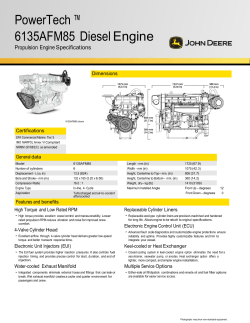
HOW TO TAKE THE "GO" OUT OF KARTING
HOW TO TAKE THE "GO" OUT OF KARTING Ted Davis MPH 338 Page 25 It was after I had departed to the world of automatic transmissions that Harpers, in their ignorance, actually tried to market a Go-Kart engine, using as a basis, the 100cc Vincent universal industrial engine which was designed to produce 2.2 bhp at 2,000 rpm. You never could make a silk purse out of a sow's ear. Although the power was more than trebled and they were sold in handed pairs, one for each rear wheel, they were still abysmally slow, memories of the Vincent scooter (not the water model) - but not much quicker. By a stranger coincidence, at the time of writing, I am developing a version of this engine using a revolutionary piston/cylinder/transfer port arrangement, pointless ignition and several other ingenious means of producing power (albeit not much) at low initial cost. Not for "No-Go-Karts"-just for cutting grass. Still, you never know, might power a bushwhacker with it one day. This "Memory" is however of the few abortive attempts to use the little Vincent universal engine on Go-Karts while I worked at the factory (strictly not works-supported). Enclosed pictures show what one finished "private" job looks like-200cc twin, horizontal parallel cylinders. 3/4 inch single Zenith carb, output shaft driving via a chain to the left hand end of the solid axle. (Power output, as Rolls-Royce say, was adequately pronounced in ad.) Stub meggaphone exhausts were for noise effect? (Who said no wonder it wouldn't go?) At the risk of sounding ridiculous I could say they probably reduced the "performance". Note spiral "go-faster" stripes-they didn't help either. Above: the "power house" of the Vincent go-kart. It looks quite impressive, but . .: supplied by Ted Davis. Above: the front view. Photos The name "universal" was no idle boast - applications ranged from boats to diggers (not grave!). The cylinders could be assembled to the magneto housing in any of four positions at 90 degree intervals. Furthermore, cylinders could be added (up to any number) in bolt-on kit form with necessary spark mods, 75cc or 100cc each pot, linked with a short crank-type coupling. We should have built up a nine-cylinder job and put it in a bike - at least we could have been first once again (and the last - hopefully!). Just imagine nine cylinder, 19.2 bhp at 2,000 with power falling off at 2,100 and five feet long. I'm still laughing at some of the things we actually did - wouldn't have got up off the floor yet with that one. However, back to the potent "looking" job in the picture. I believe I mentioned driving it in a previous "Memory" - its top speed was 14 mph . . . everyone assumed you had said 40 so it wasn't quite so bad. Main thing was to ensure it never appeared in an actual Go-Kart race (unless they were offering a whacking great booby prize). I actually did race a Kart for a while in the late 60's. Great fun, especially on the grass, but I had to go foreign for a power unit, that is if Villiers qualify as "foreign". Today's disc-braked, 10,000 rpm, 40 plus bhp jobs, are lapping circuits quicker than Formula 1 Ferrari's did in the early 50's. No, I guess powering Karts was not one of the "great" things that happened at Stevenage; that's not to say the little Vincent's were totally useless. I found one recently in Buckinghamshire that had run for 20 years - no, not non-stop) on a "Versatiller". The little garden cultivator made wholly by Vincent. Two 75's ran virtually non-stop for 1,000 hours at the factory in 1956 and they would run quite happily on paraffin using less than a pint per hour on full chat. 1 I have collected a few of these little power units. along with their smaller brothers the "Firefly". Maybe I will make that nine cylinder job after all (water cooled, of course)! 2
© Copyright 2025





















